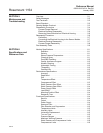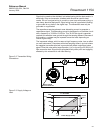
Reference Manual
00809-0100-4514, Rev BA
January 2008
Rosemount 1154
2-4
The piping between the process and the transmitter must transfer the
pressure measured at the process taps to the transmitter. Possible sources of
error in this pressure transfer are:
•Leaks
• Friction loss (particularly if purging is used)
• Trapped gas in a liquid line or trapped liquid in a gas line (head error)
• Temperature-induced density variation between legs (head error), for
differential transmitters
To minimize the possibility of errors, take the following precautions:
• Make impulse tubing as short as possible.
• Slope tubing at least one inch per foot up toward the process
connections for liquid and steam.
• Slope tubing at least one inch per foot down toward the process
connections for gas.
• Avoid high points in liquid lines and low points in gas lines.
• Use impulse tubing of sufficient diameter to avoid friction effects.
• Ensure that all gas is vented from liquid tubing legs.
• Ensure that impulse tubing is of adequate strength to be compatible
with anticipated pressures.
For differential transmitters, also consider the following:
• Keep both impulse legs at the same temperature.
• When using sealing fluid, fill both piping legs to the same level.
• When purging, make the purge connection close to the process taps
and purge through equal lengths of the same size tubing. Avoid purging
through the transmitter.
Conduit The conduit connection to the transmitter is
1
/2–14 NPT. Use a qualified
conduit seal at the conduit entry to prevent moisture from accumulating in the
terminal side of the housing during accident conditions. To prevent the conduit
from adding mechanical stress to the transmitter during seismic disturbances,
use flexible conduit or support the conduit near the transmitter. Install the
conduit seal in accordance with the manufacturer’s instructions or use the
procedure on page 2-8.
ELECTRICAL
CONSIDERATIONS
This section contains information that you should consider when preparing to
make electrical connections to the transmitter. Read this section carefully
before proceeding to the electrical installation procedures.
The Rosemount 1154 pressure transmitter provides a 4–20 mA signal when
connected to a suitable dc power source. Figure 2-2 on page 2-5 shows a
typical signal loop consisting of transmitter, power supply, and various
receivers (controller, indicator, computer, etc.). The power supply must supply
at least 12 volts to the transmitter terminals at 30 mA (overscale) signal, or the
maximum output current required for proper system operation. Any power
supply ripple appears in the output load. The supply voltage versus load
limitation relationship is shown in Figure 2-3 on page 2-5. See qualification
report D8400102 for details. The load is the sum of the resistance of the
signal leads and the load resistance of the receivers.


















